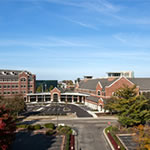A new academic research building known as the EPISCENTER (short for Electrical Power Integrated Systems Center) is the first LEED-certified building on the University of Dayton campus in Dayton, Ohio. Designed by Hastings+Chivetta and operated by General Electric’s Aviation Division, the facility assists GE aviation engineers in collaborating with faculty from the state’s largest private university to develop electrical power systems for aircraft ranging from private and commercial passenger planes to military fighter jets and unmanned drones.
“What’s happening inside this building is a unique program to simulate and test complete electrical power systems in airplanes,” architect Chris Chivetta says.
The EPISCENTER is the first campus building project that set sustainability as a project requirement. Aviation research includes computer modeling, simulation and analysis of electronic design and controls, including starter/generation, conversion, and distribution technologies. Due to the significant internal loads needed to test the aircraft electrical power packs, energy efficiency was especially challenging. The building’s electrical service equals that of the system serving the entire Dayton campus.

Engineering labs, large enough to fit a Boeing 777 fuselage, are daylit through bays of large clerestory windows, reducing energy use.
“With the energy consumption in the building, it was not easy to get LEED points,” Chivetta says. “We had to strategize ways to reduce energy consumption, minimize heat generation, and maximize heat capture and reclamation.”
With 51,000 square feet of office space and 91,430 square feet of high-bay laboratory space (enough room to accommodate the complete fuselage of a Boeing 777), the four-story EPISCENTER is designed in three sections linked by an enclosed walkway: the main entry and formal reception area, offices and administration spaces, and labs. Clerestory windows invite daylight and showcase views of the Great Miami River.
The building’s heating-and-cooling plant is a unique system of five 250-ton, heat-recovering water-cooled chillers that can accommodate the lab’s widely fluctuating cooling process loads. Each chiller can generate chilled water and hot water simultaneously.
The new building is the cornerstone of Ohio’s Aerospace Hub, a state program to promote urban renewal and economic partnerships between private industry and academic institutions and encourage technological development in the region.

EPISCENTER’s sustainable design builds on the university’s ongoing green initiatives.
The sustainable design dovetails with the university’s ongoing green initiatives, which include providing report cards to students showing energy use; diverting more than 1,000 tons of recyclable and compost material to landfills annually; building five new houses in student neighborhoods using green construction; reducing natural gas and electricity consumption on campus; and working with the Dayton community to reduce the region’s carbon footprint by 2050.
GE is the EPISCENTER’s long-term tenant, and Hastings+Chivetta designed the building to the company’s specifications, following the GE Green Building Guidelines, which are similar to the standards set forth by the USGBC for LEED.
The tight construction schedule—about 18 months between groundbreaking and opening in fall 2013—reflects a push to keep abreast of a rapidly changing industry. Research areas go beyond aviation and involve designing longer-range electric vehicles and smarter utility power grids for more efficient delivery of electricity.

